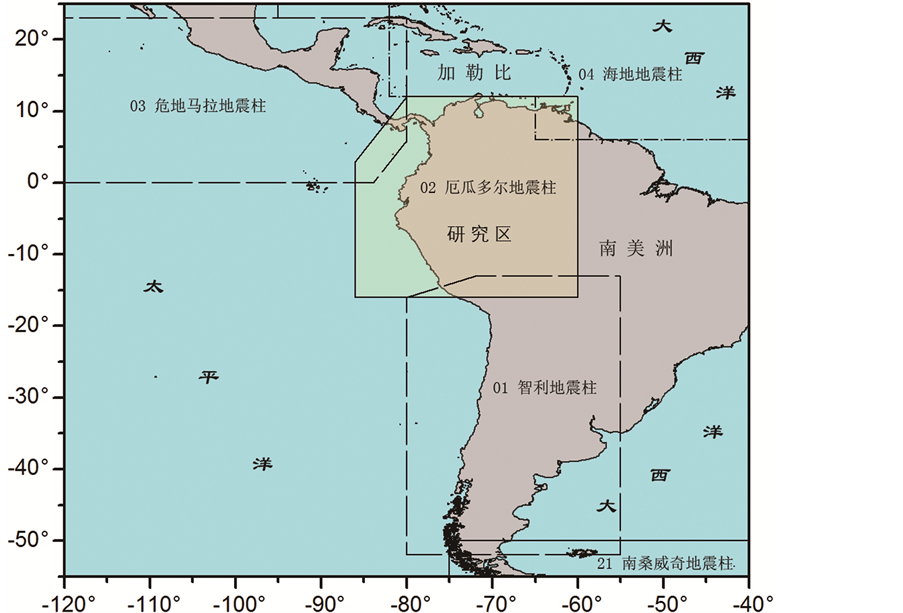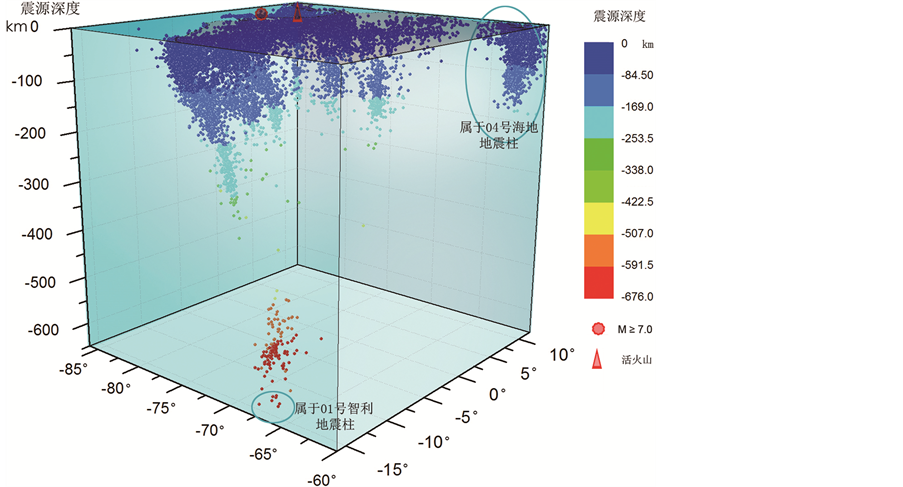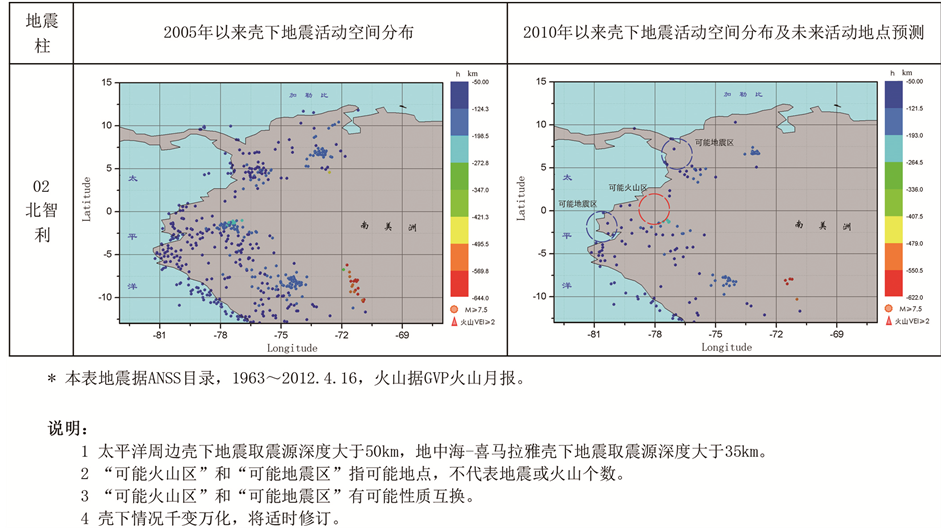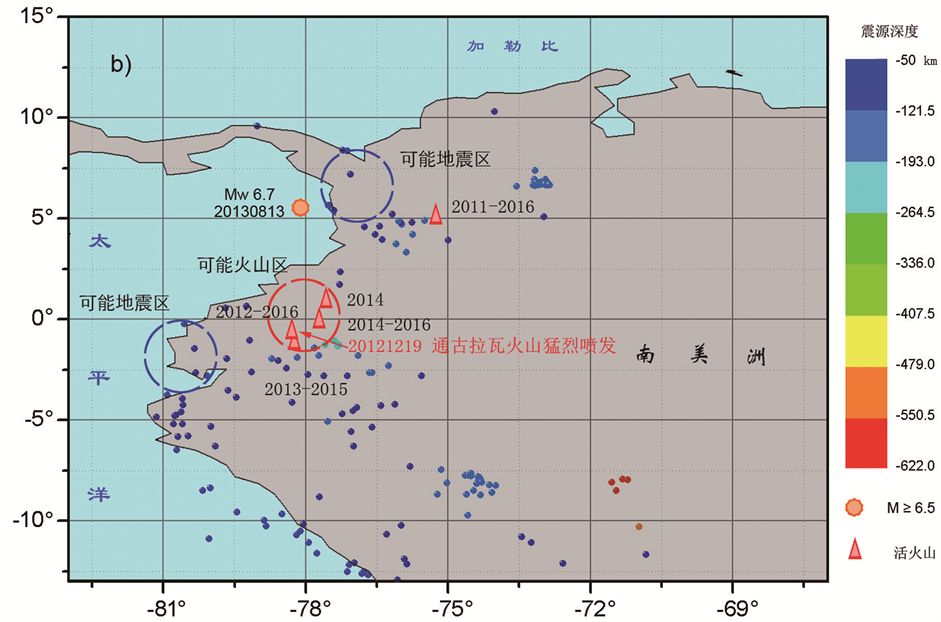1. 引言
厄瓜多尔地震柱,是作者所定义的全球24个地震柱之一,原名“02号北智利地震柱”,位于南美洲西北部,包括秘鲁、厄瓜多尔和哥伦比亚的壳内强震与火山活动,是全球地震与火山活动极为频繁的地区之一。人们对该地区地震与火山的成因通常是以板块的“碰撞”和“俯冲”来解释,本文则按照作者所提出的地震地热说关于地震柱构造的概念,以及壳内强震与火山预测的原理和方法 [1] - [12] ,采用美国的ANSS地震目录,研究地震柱构造内的地震与火山活动规律,对该地区的地震活动机理做出新的解释,并由此可以引出相关的预测思路与预测方法,对于该地震柱乃至全球的壳内强震与火山活动的预测研究是有益的。
2. 资料选取与研究方法
作者将全球24个地震柱中与人类生命攸关的23个划分为8个预测研究区,只有21号南桑威奇地震柱在外 [13] 。图1为第1个预测研究区,包括01号、02号、03号和04号4个地震柱。本文研究区地理范围为60˚~86˚W,16˚S~12˚N,采用北加利福利亚地震数据中心的ANSS地震目录,获得研究区内3级以上地震记录17,326条。其中,4.0级以下地震3111条,4.0~4.9级11,548条,5.0~5.9级2397条,6.0~6.9级236条,7.0级以上地震目录34条,最大震源深度676 km。本区最大震级8.2级,发生在631 km的地

Figure 1. Geographical position of Ecuador seismic cone
图1. 厄瓜多尔地震柱的地理位置
幔深部,属于01号智利地震柱。厄瓜多尔地震柱构造的最大深源地震7.6级。壳内最大地震8.0级,2007年发生在秘鲁中南部。2016年4月16日的7.8级地震位于厄瓜多尔境内,为该地震柱内第二大壳内强震,2016年5月18日同一地点接连发生6.7级和6.8级强余震。
按照古登堡-里克特关于大小地震的比例关系,显然3.0~3.9级地震的资料不全。好在本文方法对大小地震的比例要求不严格,只要确认是地震,就必然带有地壳或地幔的信息,因而研究中未剔除4级以下的地震。
本文的研究方法,是根据区域内中深源地震活动的三维分布状态,确认该地区的地震柱构造,研究地震柱构造内部的地震活动规律,以寻找地震与火山预测的可能途径。
地震地热说原理认为,全球的强震活动与火山活动由地球上的热机带和冷机带两大构造系统所制约;热机带由24个已知的地震柱组成,控制着全球的所有中、深源地震和92%以上的壳内强震以及83%以上的活火山,在全球呈M型展布,是全球地质灾害的能动带;冷机带主要沿大洋海底中脊出现浅源地震和少量火山活动,全球呈W型展布,表现为地质灾害的调整带 [2] [10] 。
地震柱构造的概念(seismic cone,曾被称为seismic cylinder 或者地震地幔柱seismic mantle plume)由一个或多个地震柱单柱体复合而成,已知最大深度740 km [4] 。单个的地震柱柱体构造由中、深源地震的震源体密集而成倒立的圆锥体,具有独立的能动层(含恆热层和次级能动层)、储能层和影响区的耗散层 [7] ,地震活动所标示的热能活动自下而上逐层驱动,由储能层内所积累的热能提供火山喷发的热物质和热能,或转化为壳内强震所需要的机械能,推动地表构造活动。
所谓壳下地震,笼统地指深度小于35 km的地震。对于青藏高原地区,这个说法不准确。研究表明,35 km的深度界限,已经将壳内地震与深部地震截然分开 [14] - [16] 。所谓壳内强震,因为考虑到震源深度测定的不确定性,笼统地指深度小于35 km或者50 km的强震,视地震柱构造内部的活动状态而定。根据作者以往的研究 [17] - [19] ,本文壳下地震取深度大于35 km的地震,壳内强震取深度小于50 km的地震。壳内强震一般指7级以上地震,活动性较弱的地震柱构造,取6.5级以上或6级以上地震。
3. 厄瓜多尔地震柱构造的地震与火山活动
作者以往曾对厄瓜多尔地震柱做过研究 [14] - [16] ,也曾做过壳内强震与火山的试验预测 [12] 。然而,随着时间的推移,资料逐渐地丰富,该地震柱构造逐渐成为一个很好的预测研究平台。
3.1. 厄瓜多尔地震柱的地震与火山分布
厄瓜多尔地震柱1963~2016年的地震与火山活动分布见图2,壳下地震的分布见图3。图中的断层构造据Robert T.等人的研究成果汇编而成 [20] - [29] ,只有沿南美洲西海岸的虚线和安第斯山南段的虚线是根据本文的需要推测的。沿西海岸的虚线表明这里的海沟并没有完全贯通,近几十年的壳内强震大多发生在虚线的断续处就是证据(图3)。沿西海岸的海沟显然存在一些闭锁段,壳内强震活动的态势正是试图打通这些闭锁段。
按照对全球地震柱构造的划分结果,图3在02号厄瓜多尔地震柱的周边标明了那些分别属于01号智利地震柱、03号危地马拉地震柱和04号海地地震柱的地震分布。因此,只有图中4个黄色多边形内才是属于02号厄瓜多尔地震柱的地震。
按照这个分区,则属于本文研究区内的壳内强震和火山分别如表1和表2。表1包含7级以上的壳内强震15个,表2包含活火山9座。这些火山均为地震柱型火山 [10] ,所喷发的气柱或烟柱可高达数百米或数千米(据GVP网页http://volcano.si.edu/volcano.cfm?vn=火山编号)。
由图2和图3可见,该地震柱内的浅源地震活动皆沿着南美洲西海岸成团分布,或者沿着相关断层成团分布,活火山则主要沿Fritz E.等(1946)所确定的年轻岩体呈北东走向分布 [22] 。

Figure 2. Seismic and volcanic distribution in the Ecuador seismic cone (according to ANSS and GVP, 1963-2016, M ≥ 3.0, VEI ≥ 2)
图2. 厄瓜多尔地震柱的地震与火山分布(据ANSS地震目录和GVP火山月报,1963~2016,地震M ≥ 3.0,火山喷发指数VEI ≥ 2)

Figure 3. Subcrustal earthquake and volcanic distribution in the Ecuador seismic cone (according to ANSS and GVP, 1963-2016, M ≥ 3.0, VEI ≥ 2)
图3. 厄瓜多尔地震柱的壳下地震与火山分布(据ANSS地震目录和GVP火山月报,1963~2016,地震M ≥ 3.0,火山喷发指数VEI ≥ 2)

Table 1. Intracrustal strong earthquakes M7+ in the Ecuador seismic cone (according to ANSS catalogue, 1963-2016)
表1. 厄瓜多尔地震柱7级以上壳内强震(据ANSS地震目录,1963~2016)

Table 2. The active volcanoes in the Ecuador seismic cone since 1960 (according to Smithsonian Institution, 1960-2016)
表2. 厄瓜多尔地震柱1960年以来的活火山(据Smithsonian Institution,1963~2016)
图4为深度在50 km以下和100 km以下的地震分布。由图4可见,越往下,地震活动的密集度就越高,深部地震活动与壳内强震及火山活动的关系就显得更加清晰。
图5为该地震柱地震活动的三维分布。图中显示,深源地震活动的中心位于巴西的西部,往上有6个倒立的圆锥体与之相连,或者说圆锥体的下端都一致性地指向深源地震活动中心。6个圆锥体深度不一,规模不一,其活跃程度显然也不一样。
3.2. 厄瓜多尔地震柱的活动性分析
上节展现了厄瓜多尔地震柱的基础资料和图件,本节研究该地震柱的整体活动性。
为了研究方便,图3中划分了4个单体地震柱,分别为a、b、c、d等4个分区,并分别给出其震源深度时序图如图6。图6同时给出了各个分区的壳内强震与火山随时序的活动。
按照本文的研究方法,厄瓜多尔地震柱的整体地震活动大致可以分为5个地层,即深度500 km以下为超级能动层,300~500 km为恆热层,150~300 km为次级能动层,50~150 km为储能层(或含有熔岩囊),0~50 km为影响区内的耗散层 [7] 。中深源地震活动所释放的能量,不论是热能或者机械能,都无法耗散,只能向上转移,从而造成地震活动“自下而上逐层驱动”之势,能量积累在储能层内,最终通过壳内强震或火山活动以热能或者机械能的形式释放殆尽。多数地震柱的恆热层内基本无地震活动,表明深源地震所释放的能量在该层内不能停留,直接向上层转移。
图6a的能动层几乎包含了本地震柱的所有深源地震,并且随着次级能动层的活动增强而出现壳内强震活动。近几十年秘鲁中部没有活火山,南部的火山活动属于01号智利地震柱。图6b同样随着次级能动层的活动增强而出现壳内强震活动,陆地上有5座活火山,火山活动强烈。图6c储能层内地震活跃,壳内强震和火山也较为活跃。图6d集中在次级能动层内活动,壳内和储能层内地震皆不活跃,壳内最大地震为1995年1月19日的6.6级地震。图6d的活动态势和作用暂不明了,似乎有一种俗话所说的为a、b、c等3个分区“敲边鼓”的味道。
图6b往西,东太平洋厄瓜多尔属地加拉帕戈斯(Galapagos)群岛(科隆群岛)的费尔南迪纳岛(Fernandina Island)火山活动,可能属于东太平洋大洋中脊的地幔柱型火山 [10] [30] ,与厄瓜多尔地震柱构造的活动关系不大,因此没有划入02号厄瓜多尔地震柱的构造范围。
综合图3和图5的效果,显然深源地震是由图6a一家管总,因而只能将4张图的效果合并才能为所有壳内强震与火山活动提供能量。合并效果图如图7。

Figure 4. Subcrustal earthquake and volcanic distribution in the Ecuador seismic cone (according to ANSS and GVP, 1963-2016, M ≥ 3.0, VEI ≥ 2); a) depth h ≥ 50 km; b) depth h ≥ 100 km
图4. 厄瓜多尔地震柱不同深度的壳下地震分布(据ANSS地震目录和GVP火山月报,1963~2016,地震M ≥ 3.0,火山喷发指数VEI ≥ 2);a) 深度h ≥ 50 km;b) 深度h ≥ 100 km
由图7可见,1995~2012年能动层的深源地震活动表现出成团的活动,图中用一个蓝色的虚线框框圈住。这个框框的直径约为17年,与作者所估计的地幔年代际振荡的周期基本相当 [31] 。深源地震中包括5个7级以上的强震,最大震级Mw7.6。上下关联,显然自2012年以来的壳内强震和火山的活动群与蓝色框框内的深源地震及其上行的中源地震活动有关。换句话说,地震柱的壳内强震与火山活动的能量可能来自地幔的深部,而不是某种地表构造的活动所为。
由这个蓝色框框向前看,该地震柱上世纪70年代和90年代的壳内活动,也存在与此类似的情形,只是

Figure 5. Seismic 3D distribution of the Ecuador seismic cone (according to ANSS and GVP, 1963-2016, M ≥ 3.0, VEI ≥ 2)
图5. 厄瓜多尔地震柱的地震三维分布(据ANSS地震目录和GVP火山月报,1963~2016,地震M ≥ 3.0,火山喷发指数VEI ≥ 2)

Figure 6. Sequence diagram of seismic source depth of single cone in the Ecuador seismic cone (according to ANSS and GVP, 1963-2016, M ≥ 3.0, VEI ≥ 2)
图6. 厄瓜多尔地震柱的单体地震柱震源深度时序图(据ANSS地震目录和GVP火山月报,1963~2016,地震M ≥ 3.0,火山VEI ≥ 2)

Figure 7. Comprehensive sequence diagram of seismic source depth of the Ecuador seismic cone (according to ANSS and GVP, 1963-2016, M ≥ 3.0, VEI ≥ 2)
图7. 厄瓜多尔地震柱的综合震源深度时序图(据ANSS地震目录和GVP火山月报,1963~2016,地震M ≥ 3.0,火山VEI ≥ 2)
深源地震活动的强弱有别而已。当然,还包括资料的完整性问题。显然,越往前,对地震的监测能力越弱。
3.3. 厄瓜多尔地震柱的特殊结构
图5中的6个圆锥体就是厄瓜多尔地震柱的单体地震柱。它们像是6根通向地幔深部的管道,构成中深源地震活动的习惯性通道,结构稳定,经久不变,周边也未见由于观测仪器的改进和数字分析技术的提高而引起的系统偏差。
图3中的4个单体地震柱的划分其实是不得已而为之,因为太小的圆锥体难以分离出来单独统计分析,只能划分为4个大区。
对于单体地震柱,由其出地点指向深源地震中心的剖面,可以称之为本征剖面 [9] 。过本征剖面可以画出类似于本尼奥夫剖面的图像,其物理意义在于它能够描述地震柱的本质。
该地震柱过厄瓜多尔圆锥体的本征剖面如图8所示。其他圆锥体也可以画出同样的剖面来。图8标注了地震柱的多种基本要素,包括地震柱的主要地层结构、深源地震活动区、出地点及其影响区。图中的黑色虚线是地震柱圆锥体的某一条母线,因此这样的剖面离开圆锥体就没有意义了。图中的红色虚线为推测的熔岩囊。根据意大利埃特纳火山的经验,有火山活动的地区,储能层里面的熔岩囊内地震活动或许较少 [8] 。做本征剖面图像时,只有选择合适的尺度才能发现熔岩囊的存在。
由是观之,地震柱的本征剖面与人们常见的本尼奥夫剖面性质是不同的。
本文从哈佛大学网站(http://www.globalcmt.org/CMTsearch.html)和美国地质局调查所网站
(https://www2.usgs.gov/natural_hazards/)获得研究区16条6.8级以上壳内强震(其中有1条新近的6.7级强余

Figure 8. One of the intrinsic profiles of the Ecuador seismic cone(according to ANSS and GVP, 1963-2016, M ≥ 3.0, VEI ≥ 2)
图8. 厄瓜多尔地震柱的本征剖面之一(据ANSS地震目录和GVP火山月报,1963~2016,地震M ≥ 3.0,火山VEI ≥ 2)
震)的震源机制解,列于表3。由表3可见,壳内强震均发生在西海岸或者靠近海岸地区,其中只有哥伦比亚西海岸有1条属于正断层面解,其余全部为逆断层或者逆冲断层面解。如果我们推测地震断层面解的主破裂面是沿着南美洲西海岸的(表中的红色字符标志),则必然存在某种力量推动这些逆冲断层。这种力量可能就来自地震柱柱体本身的某种运动,从而造成了地震柱构造影响区内地震活动的广泛逆冲和扇状分布。
以上分析,显示了厄瓜多尔地震柱的一种特殊结构。由图3看,4个单体地震柱朝北西方向呈扇形展开,由图5看,6个圆锥体向南、向东倾斜,一致性地指向深源地震中心。整个地震柱构造可以形象地比喻为一只左手的手掌型结构:深源地震活动中心为其腕部,恆热层为其掌心,负责沟通各个圆锥体,秘鲁圆锥体为其大拇指,厄瓜多尔圆锥体和哥伦比亚圆锥体分别为其食指和中指,指尖便是壳内强震与火山的活动之所。
厄瓜多尔地震柱的这种手型构造,如果一张一弛,即足以提供逆冲断层和逆断层的支撑力量,而深源地震活动的韵律则控制着一张一弛的节度,以火山活动释放储能层的大部分热能,以壳内强震力图疏
表3. 厄瓜多尔地震柱6.8级以上壳内强震的震源机制解(1976~2013,据http://www.globalcmt.org/CMTsearch.html,2016据USGS)
*RLT为右旋逆冲断层,LLT为左旋逆冲断层,LLI为左旋逆断层,RLI为右旋逆断层,RL或LL为正断层,红色字符为沿西海岸的破裂面。2016年资料据USGS。
通南美洲西北部的海沟,以求保持手型结构活动的自由度。
当然,以太平洋板块向东的“俯冲”也可以解释这里断层的逆冲现象,然而图6和图7显示该地震柱的中深源地震活动并非呈“俯冲”模式。
由图7可见,深源地震活动比地震柱的壳内活动提前若干年,因而有足够的时间让人们做好心理准备。工作做好了,该地震柱的壳内强震与火山活动的预测便是可能的。
以上分析,部分源自实际资料,部分源自推测。科学研究是允许根据一定的实际资料推测的。这就叫做去粗取精,去伪存真,由此及彼,由表及里,由事实到本质的研究方法和认知过程。
4. 关于厄瓜多尔地震柱的地震与火山预测研究
以上研究,为厄瓜多尔地震柱的壳内强震与火山活动的预测提供了可能性。作者于2012年4月19日曾向我国有关地震部门提交了一份未来3年内全球主要地震柱壳内强震与火山的活动时段和活动地点的预测卡片,简称0419卡 [11] [12] 。该预测卡片对厄瓜多尔地震柱,当时称为北智利地震柱,的活动地点预测见图9,是按照2005~2012年和2010~2012年壳下地震活动的差异做出的。“可能火山区”画在地震柱柱体的出地点附近。这是火山地点预测的基本原则。
该卡的“可能火山区”内于2012年12月19日厄瓜多尔通古拉瓦是强烈喷发,当时作者感到十分庆幸 [32] 。现在总结发现,这个“可能火山区”在3年预测期(2012~2015年)内其实有4座火山喷发,其实际情况见图10。
图10的结果告诉我们,地震柱内的壳内强震与火山活动是可以预测的。本文的研究前进一步,大致可以总结如下的思路:
1) 对于厄瓜多尔地震柱的壳内强震预测强度,可取7级以上,当然包括接近7级的地震。
2) 地震地点的预测可取西海岸海沟的闭锁段,即图3中的断续处。至于强震到底会发生在那个分区内,则需要按照图6的方法对单体地震柱逐个检视判断。值得指出的是,图6中似乎有a、b、c三个分区的壳内强震同步活动的现象。孰先孰后,值得研究。在本次强震的后续活动研究中,尤其应关注到这样的可能性。作者手头的资料,不足以研究本次强震的后续活动。
3) 未来的火山活动多出现在单体地震柱的出地点附近,因为它们距离熔岩囊最近。
4) 地震柱的活动时段预测采用图7的方法,按照深源地震活动群的活动向上推演。根据图7的活动趋势,目前的强震与火山活动还会持续相当长的一段时间,以年计。至于未来的活动,可能要等待下一个深源地震活动群的出现。
本文所采用的地震资料过于粗略,如果拥有本地的地震目录,能够有效监测2级以上的地震活动,按照上述方法可能效果更佳。未来壳内强震和火山活动的地点,越临近发生,越需要依靠壳下地震活动的密集区与地表活动构造的关系来加以判定,因此地震目录的精度越高其可信度也越高。

Figure 9. The test card for Ecuador seismic cone in card 0419
图9. 厄瓜多尔地震柱的试验预测卡片

Figure 10. Prediction test of card 0419 for Ecuador seismic cone
图10. 预测卡0419卡片对厄瓜多尔地震柱试验预测的检验
5. 讨论与结论
本文详细分析了厄瓜多尔地震柱的地震活动、火山活动,以及地震柱的构造结构,试图为该地震柱的壳内强震与火山预测探讨一些研究的思路与方法,至少可以形成如下一些要点:
· 人们常常认为,壳内强震活动的能量来自地表构造运动,比如构造体系的活动,地块的活动,或者板块的“碰撞”和“俯冲”,统称为“构造应变能的释放”。本文的研究表明,壳内强震活动和火山活动与地震柱构造内部的中深源地震活动紧密相关。试想,600多千米深的8级大震,地表构造不可能参与活动,只能靠高温高压条件下的热能不均匀性来凝聚,而8级深震所释放的能量又无法向地球之外耗散,就只能由高温高压条件的地层向相对低温低压条件下的地层转移,自下而上逐层驱动,因此我们才有可能见到如图6和图7那样的时序活动图像。
· 由图7可见,深部地震活动具有韵律,壳内的地震与火山活动也具有韵律,只有找出二者的相互关联,才能破解地震与火山之谜。为此,需要有高精度的地震监测网。本文资料只获得1万多条4级以上的地震资料,很多已经发现的现象还是不够精确的,如果像地中海地震台网那样实现对1级以上地震的有效监测,我们的认识就可以大大提高一步。作者最近发表的爱琴海7级地震的孕震过程和孕震机理,就是依据地中海的微震活动资料发现的 [9] 。这篇文章首次用动画来展示强震的孕育过程,具有令人惊喜的视觉效果。
· 地震柱构造的活动,肯定会积累一定的能量,壳内强震与火山的活动便是地震柱构造释放能量的一对孪生兄弟。全球的火山研究做了很多很好的工作,积累了大量宝贵的资料,让人钦佩,可以借鉴。但是,火山的研究不能只限于对火山破裂-喷发方式的研究,火山的预测也不能仅限于微地震、地表形变与水质分析的观测与研究,而应该与地震柱的研究相关联。火山口的破裂与火山喷发的方式不是真正的火山成因,必须找到火山能量和热物质的来源 [10] 。本文的研究表明,把地震柱构造的活动性研究清楚,火山的喷发机制的研究与预测也是可以有突破的。
· 厄瓜多尔地震柱的壳内强震与火山的预测研究,值得引起广泛注意。因为,壳内强震与火山预测研究的突破,一是需要寻找“安静”的环境,二是需要高精度的地震观测资料。虽然厄瓜多尔地震柱的第二个条件不太满足,但是具有很单纯的地震活动环境,没有很复杂的干扰,地震柱构造的活动期间隔清晰。全球地震柱的构造结构千姿百态,厄瓜多尔地震柱构造的手型结构虽然说法有点不雅,但是很形象,很生动。当然,地中海的研究环境更为优越,两个条件都很具备 [8] [9] 。
综上所述,按照地震地热说关于壳内强震与火山预测的方法,本文采用北加利福利亚地震数据中心的ANSS地震目录,Smithsonian Institution的GVP火山资料,对厄瓜多尔地震柱的地震活动与地震柱构造进行广泛研究,初步认为研究区内的地震柱构造结构表现为一种左手的手型结构,深源地震活动的韵律致使手型结构一张一弛从而控制着地震柱构造影响区内的壳内强震与火山活动,火山活动释放储能层的大量热能,壳内强震则力图疏通南美洲西北部的海沟,以保持手型结构活动的自由度。由于深源地震活动比地震柱构造影响区内的活动提前若干年,有足够时间让人们做好心理准备,工作做好了,该地震柱内壳内强震与火山活动的预测便是可能的。厄瓜多尔地震柱构造具有优越的地震研究环境,值得人们关注。
基金项目
本文感谢北加利福尼亚地震数据中心提供的ANSS地震目录(http://dx.doi.org/10.7932/NCEDC),火山资料取自Smithsonian Institution的Global Volcanism Program (GVP)网站(http://volcano.si.edu/),地震震源机制解资料来自哈佛大学网站(http://www.globalcmt.org/CMTsearch.html)和美国地质局调查所的网站(https://www2.usgs.gov/natural_hazards/),同时感谢中国地震局离退办提供的老专家科研基金课题资助,项目编号201601。